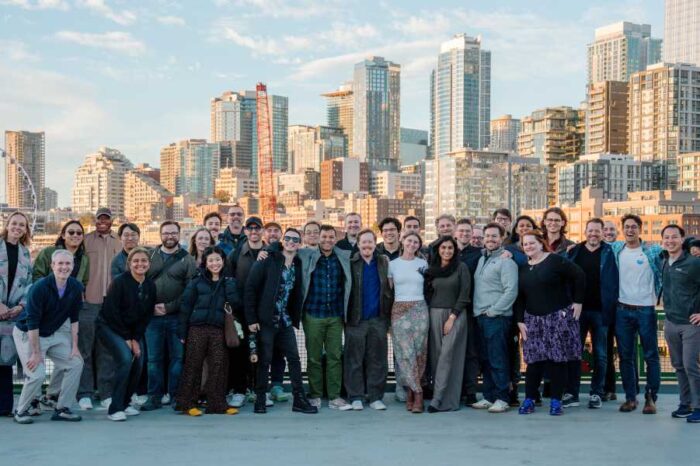Has AI finally come for white-collar jobs? The real story behind corporate America’s mass layoffs

Following our recent report on Tech Layoffs 2025, a new wave of white-collar cuts across Corporate America raises a tougher question: are these jobs truly disappearing because of AI, or is it a convenient cover for deeper corporate problems?
Last week, in our piece “Tech Layoffs 2025: Comprehensive List, Trends, and What They Mean for the Industry,” we tracked more than 184,000 tech workers laid off this year and showed how AI spending, investor pressure, and a post-pandemic reset have reshaped the hiring map from Silicon Valley to Bangalore. That story focused on engineers, product teams, and operators inside tech companies.
This week, the same forces are colliding with a different group: white-collar workers across Corporate America. Now, an exclusive in-depth analysis from CNBC has raised questions about whether these layoffs — spanning companies like Amazon, UPS, and Target — mark the start of an AI-driven white-collar recession or a broader cost-cutting wave disguised as innovation.
At one level, the headlines sound familiar. Companies say they are trimming “corporate bloat,” streamlining decision-making, and reshaping teams for an AI-heavy future. At another level, the numbers have landed in a vacuum. The Bureau of Labor Statistics’ monthly jobs report has gone dark during the government shutdown, so there is no fresh official snapshot of hiring and firing. That silence has turned every layoff announcement into a signal investors and workers are trying to decode: is this the start of an AI-driven white-collar recession, or a classic cost-cutting cycle dressed up in new language?
AI is part of the layoff story — and a convenient villain
Some companies are blunt. Klarna CEO Sebastian Siemiatkowski said in May that the company was able to shrink its headcount by about 40%, in part because of AI. Duolingo said in April it would stop using contractors for work that AI can handle. Salesforce laid off 4,000 customer support roles in September, saying that AI can do 50% of the work at the company.
Those examples feed a simple narrative: AI arrives, white-collar jobs vanish. Yet experts who study how firms actually implement automation say that the story is far too clean.
“We spend a lot of time looking carefully at companies that are actually trying to implement AI, and there’s very little evidence that it cuts jobs anywhere near like the level that we’re talking about. In most cases, it doesn’t cut headcount at all,” said Peter Cappelli, a professor of management at the Wharton School and director of its Center for Human Resources. “Using AI and introducing it to save jobs turns out to be an enormously complicated and time-consuming exercise … There’s still a perception that it’s simple and easy and cheap to do, and it’s really not.”
That gap between perception and reality opens the door to something else: “AI-washing.” If profits are under strain, or a strategy misfired, or a pandemic hiring spree went too far, blaming layoffs on AI can sound more forward-looking than admitting old-fashioned overreach. AI becomes a storyline executives can point to, even if the real driver is margin pressure or a bad bet.
A shaky economy, a euphoric market
This wave of cuts is landing in an economy that already looks fragile. Inflation has stayed stubborn, delinquencies are climbing, consumer sentiment has softened, and the average effective tariff rate is at its highest level in nearly a century, based on estimates from The Budget Lab at Yale University.
None of that has knocked the stock market off its near-record highs, largely because AI mega-caps are propping up index performance. Investors remain in love with anything tied to AI infrastructure and AI software, even as the broader economy shows strain.
Cappelli sees that tension as a big part of the layoff story. Corporate leaders are watching the same data, fielding the same questions from investors, and in many cases reacting to one another.
“If it looks like everybody is cutting, then you say, ‘They must know something we don’t know,’” he said. He added that investors often reward cutting: “They want to hear that you’re cutting because it looks like you’re doing something good. It looks like becoming more efficient.”
So you get a self-reinforcing loop: a nervous macro backdrop, a market that cheers “efficiency,” and a set of companies that saw payrolls swell during the pandemic boom and now feel compelled to prove they can slim down. AI sits right in the middle as both a real force and a rhetorical shield.
From tech layoff trackers to a wider corporate reset
In tech, we already know the score. As of October, layoffs in 2025 have hit more than 184,000 workers across hundreds of companies. Big names like Intel, Microsoft, Meta, Amazon, and TCS have all trimmed staff while steering billions into AI, cloud, and automation projects. Startups, which once played catch-up to Big Tech on layoffs, now account for a growing share of the cuts.
That “lean” mindset is spilling over into other corners of corporate life. Starbucks recently cut around 2,000 corporate jobs as part of a turnaround push under its new CEO, Brian Niccol. Layoffs at Meta’s AI unit, affecting around 600 jobs, came as the company said it wants to “operate more nimbly” and reduce layers. Intel’s decision to lay off about 15% of its workforce followed a period in which it “overinvested in chip manufacturing” without enough demand to justify the build-out.
Taken together, these moves look less like a tech-only correction and more like a broad corporate reset. John Challenger, the CEO of job placement firm Challenger, Gray & Christmas, described it as a shift in the entire labor climate.
“We were in this no-hire, no-fire type of zone. The economy was moving ahead. The labor markets were feeling pressure, but certainly, unemployment had stayed relatively strong,” he said. “These job cuts do suggest that the dam may be breaking as the economy slows.”
He pointed to retail, shipping, and distribution as early warning signs: sectors that sit close to end demand and feel changes in consumer behavior sooner than some others.
To see how the forces behind this wave actually work, it helps to look at three names that anchor the story: Amazon, UPS, and Target. Each is cutting white-collar staff, each talks about AI, and each has its own mix of strategy, missteps, and structural pressure.
Amazon: from pandemic surge to “world’s largest startup”
During the pandemic, Amazon turned into the default store and infrastructure provider for millions of people and thousands of companies. Between 2019 and 2020, its corporate and frontline headcount more than doubled, reaching 1.3 million employees as demand for e-commerce and cloud computing spiked. By 2021, the workforce hit 1.6 million globally, the same year Andy Jassy took over as CEO from Jeff Bezos.
Jassy inherited a company that had bulked up fast. Warehouses, data centers, logistics networks, content bets, new business lines — the body grew everywhere at once.
The correction has been just as striking. Last week’s layoff announcement, affecting 14,000 corporate jobs, is expected to be the largest in Amazon’s history and will hit nearly every unit. It is the company’s second large reduction in three years and brings total corporate cuts since 2022 to more than 41,000 jobs, with more on the horizon in 2026.
Public chatter often frames these cuts as AI-driven. Jassy has taken a different line. He said in the days after the announcement that the changes were neither AI- nor financially driven, but focused on cutting corporate fat so Amazon can operate as the “world’s largest startup.”
On paper, Amazon is not replacing workers with AI, at least not yet. The company says it needs to trim staff so it can fund heavy bets in AI infrastructure and AI products. Capital expenditures are climbing, with forecasts calling for $125 billion this year, up from a prior estimate of $118 billion. Those funds support cloud infrastructure for AI workloads and a growing slate of AI services and tools across AWS and other segments.
Jassy has signaled that generative AI will reshape the workforce over time. He said the company’s headcount “would shrink in the future” as AI becomes more embedded in day-to-day work, with “fewer people doing some of the jobs that are being done today” but “more people doing other types of jobs,” a line he used in June.
The cuts sit inside a broader cultural push. Jassy keeps stressing speed and simplicity, and the belief that Amazon’s size has quietly changed how it operates.
“It’s culture,” Jassy said during Amazon’s quarterly earnings call Thursday. “If you grow as fast as we did for several years, you know, the size of the businesses, the number of people, the number of locations, the types of businesses you’re in, you end up with a lot more people than what you had before, and you end up with a lot more layers.”
In other words, AI may shape Amazon’s future staffing, but the current wave of white-collar cuts owes just as much to old-school bloat, layers of management, and a leadership team trying to reboot how the company feels internally.
UPS: fewer parcels, new strategy, and different jobs
UPS tells a different story, even though the result — thousands of lost jobs — looks similar on a spreadsheet.
In January, the logistics giant announced a major shift in strategy. It planned to shrink its reliance on Amazon, its largest customer, and move toward higher-margin business that needs fewer people to handle each dollar of revenue. In fiscal 2024, shipments tied to Amazon represented nearly 12% of UPS revenue. Management said it would cut that volume by more than half by June since it delivered weaker margins than other segments.
“This was not their ask. This was us. This was UPS taking control of our destiny,” CEO Carol Tomé told analysts in January.
The company leaned into areas such as health care, returns, and business-to-business services, lines of work that tend to support richer margins and often integrate more automation. A shift like that almost guarantees a leaner workforce.
“As we bring volume down, we will not only reduce the hours of miles associated with this volume, we will be able to take out fixed costs to match our capacity to our new expected volume levels,” finance chief Brian Dykes said in January. “We expect to close up to 10% of our building, cut back our vehicle and aircraft fleets and reduce labor.”
That plan has now produced deeper cuts than initially expected. Last week the company said it had expanded its planned reductions, reaching a total of 48,000 roles eliminated so far this year across operational employees and office workers. Parcel volumes in the first half of 2025 were down 5.4% compared to the same period the year before, based on ShipMatrix data, and UPS has been reshaping its corporate structure for a lower-volume business.
The layoffs split into two main groups. About 34,000 operational jobs are connected to the decision to close 93 buildings, rather than to direct replacement with robotics. The 14,000 corporate roles cut this year have some ties to AI and automation projects, but UPS says technology was not the primary trigger.
That does not mean automation has no impact. UPS plans to bring more automation into its facilities and has told investors that over time it will not need to hire as many people as it once did. Last week, the company said 66% of its volume during the fourth quarter would move through automated facilities, up from 63% a year earlier, with that share expected to climb.
Still, some of the jobs being lost at UPS may simply be moving elsewhere in the system. Jason Miller, a professor of supply chain management at Michigan State University’s business school, described a “reallocation” effect. One firm loses business and cuts payroll, another gains that business and adds staff. The headcount total across the sector can stay roughly flat, even though jobs change hands and locations.
BLS data on employment in “courier” roles, which covers workers at companies like UPS and Amazon, lines up with that view. As of August, courier positions were only down about 2% from their all-time high and have been trending upward over the last three years.
UPS, in other words, is leaning into a different mix of customers and a more automated network. AI matters most in how it shapes future hiring and investment, rather than in a single dramatic replacement of office workers by software.
Target: tariffs, taste, and corporate sprawl
Target’s story has more to do with tariffs, consumer behavior, and past decisions that backfired.
Last month, the retailer announced that it would cut 1,800 jobs, roughly 8% of its corporate workforce. It is the company’s first major round of layoffs in ten years and follows four years of fairly flat revenue. Incoming CEO Michael Fiddelke framed the cuts as a way to reduce complexity at a company where headcount has grown faster than sales.
Target sits in a delicate position. Unlike Walmart, which earns most of its revenue from groceries and everyday essentials, Target leans heavily on items that feel more like treats: holiday mugs, trendy sweaters, stylish home decor. Shoppers can pass on those items more easily when budgets are tight.
Slower spending has already weighed on Target’s performance. Tariffs add another layer of strain by pushing prices higher on imported goods.
“Buyers’ willingness to pay is staying flat, inflation is high, income isn’t going very up so firms’ ability to sort of increase price to maintain their margin is being squeezed,” said Daniel Keum, an associate professor of management at Columbia Business School who studies labor market dynamics. “If you can’t increase price, you have to reduce cost.
“How operationally do I manage cost?” Keum added. “I mean No. 1, like, let’s lay off white-collar people.”
Target has also been wrestling with its own choices. Customers and insiders told CNBC earlier this year that the quality of its merchandise had slipped. Stores felt thinly staffed and frequently out of stock, which made shopping less pleasant. The company has struggled with inventory planning, a problem that hurts both revenue and margins.
That mix of softer demand, tariff pressure, and internal misfires left Target with a corporate structure that no longer matched its performance. Between fiscal 2023 and fiscal 2024, Target’s global workforce grew 6%, from 415,000 employees to 440,000. Over the same period, sales fell 0.8%, based on company filings.
“The truth is, the complexity we’ve created over time has been holding us back,” Fiddelke told employees in a memo announcing the cuts. “Too many layers and overlapping work have slowed decisions, making it harder to bring ideas to life.”
He did not cite AI in that memo, though he did say the cuts would help Target move faster and “accelerate technology.” That aligns with a broader pattern across Corporate America: technology and AI show up as part of a future vision, yet the immediate trigger for layoffs is often a mix of tariffs, pricing pressure, weak demand, and accumulated complexity.
A turning point, but not a sci-fi scenario
Taken together, the stories of Amazon, UPS, Target, Starbucks, Meta, Intel, and others look less like a clean AI takeover and more like a turning point in how big companies think about white-collar work.
AI and automation clearly influence strategy. They shape where new investment goes, which roles feel safe, and what sort of skills employers prize. They give leaders a narrative they can share with investors and staff. In certain cases — Klarna, Duolingo, Salesforce — AI does stand behind direct headcount cuts.
At the same time, the broader picture lines up with what we saw in tech earlier this year. Companies that bulked up through the pandemic are now trimming back. Investors favor lean margins over bloated org charts. Tariffs and inflation squeeze product-driven brands. Logistics networks get redesigned around higher-margin customers. Retailers and shippers pass pressure up the chain to corporate staff.
The question isn’t just whether AI has “come for” white-collar jobs. The deeper question is how companies choose to use this moment. AI can become a tool to shift work, retrain teams, and open new lines of business, or a slogan that masks plain old cost-cutting.
For workers, the distinction matters. In tech, thousands of laid-off engineers are already trying to reposition themselves around AI products and infrastructure. In corporate roles, the path may be less obvious, especially for staff whose jobs sit far from any model or data pipeline.
For now, the layoff wave that started in tech has clearly jumped the fence into a broader corporate reset. AI sits at the center of that story, but it is not the only force at work — and in many cases, not even the main one.



